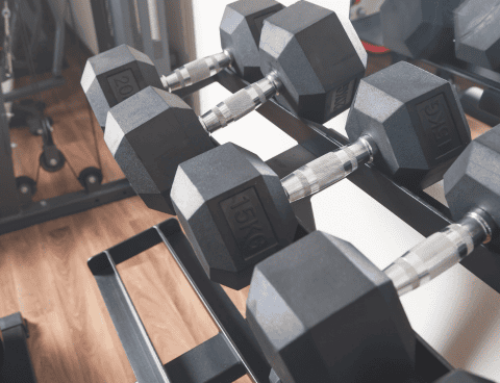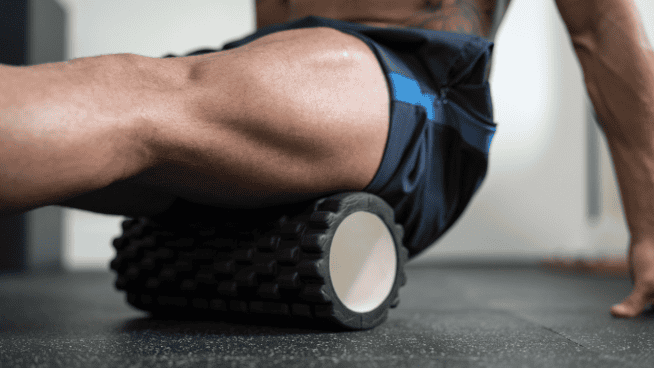The 7 Most Powerful Kettlebell Core Exercises
Kettlebells are an excellent training tool.
Thanks to their versatility, kettlebells can be used to train a huge number of different muscle groups—including those in and around the core. The core is extremely important to athletic performance, as it acts to stabilize the body and transfer energy through the limbs. Think of having a weak core like putting a flimsy link in the middle of a chain. Once enough force is involved, the link won’t be up to the task of handling and transferring that energy, rendering movement inefficient and unimpressive.
With that in mind, here are seven of the most powerful kettlebell core exercises you can utilize in your routine. Feel free to superset several of these exercises for a killer kettlebell core workout.
1. Plank With Kettlebell Pull-Through
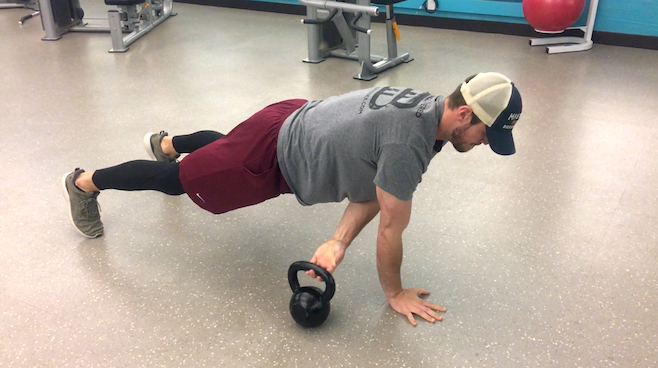
Planks have long been a staple of athletic training, but adding some dynamic movement to a static Plank can go a long way toward building functional strength through your core. By simply pulling a kettlebell from one side of your torso to the other while holding a Plank, your core must work to prevent your body from rotating. This makes the Plank with Kettlebell Pull-Through an anti-rotation core exercise. Start light with this one before progressing to heavier kettlebells. The further you place the kettlebell outside of your frame, the more difficult the exercise will become, though you should never place it so far away that it compromises the form of your Plank.
How to:
- Begin in a natural High Plank position with a kettlebell by your left side.
- While working to keep your chest parallel to the floor and resisting movement throughout the rest of your body, slide your right arm underneath yourself to grab the kettlebell handle.
- Remaining in a good Plank position with your butt down and core engaged, pull the kettlebell underneath yourself to the other side.
- Continue to pull the kettlebell to alternating sides until the set is complete.
Sets/Reps: 3×10-12 total reps
2. Resurrected Dead Bug
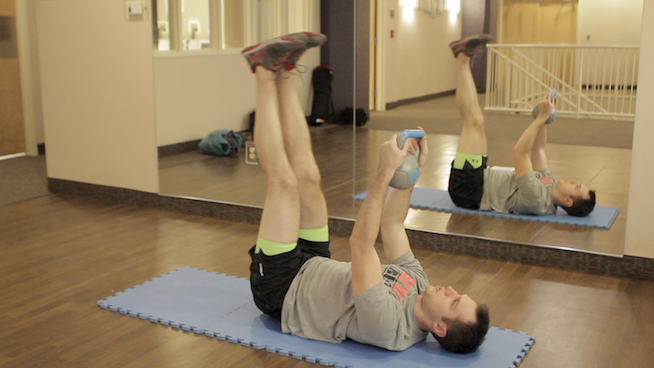
The Dead Bug has long been one of our favorite core exercises, as it trains the core to resist extension and protect your lower back. Anti-rotation and anti-extension exercises are excellent choices for your core training, as they train the musculature in a functional, natural manner.
This variation, from renowned strength expert Dan John, looks different from a standard Dead Bug, but the pattern is the same. As you hold a kettlebell over your chest, do a leg raise and drive your legs into the air. This works the frontside of your core and opens up your lower back. The key with this kettlebell core exercise is to prevent your lower back from raising off the floor as you lower your legs. While your lower back will naturally come off the mat as you pulse your feet in the air, you should work to keep your lower back in contact with the floor for the rest of the movement.
How to:
- Hold a kettlebell or med ball with your arms extended in front of your chest.
- Keeping your lower back flat on the ground and legs straight, slowly lower your legs until your feet are a few inches above the ground.
- Raise your legs up until they are perpendicular to the ground and then drive your hips into the air to pulse your feet.
- Control the descent by activating your core and repeat.
Sets/Reps: 3×8-10 reps
3. Kettlebell Turkish Get-Up
[youtube video=”KglXLn1LjGw”]Kettlebell Turkish Get-Ups are a monster of a movement. Some experts have even proposed they may deserve the title of “world’s greatest exercise,” and it’s hard to fault them. The beauty of the Kettlebell Turkish Get-Up is that it’s really four or five exercises in one. Transitioning between each of those exercise positions requires excellent functional core strength. If you’ve never performed Turkish Get-Ups before, you may want to first start without any weight to see if you have the mobility and full-body strength required to execute the move appropriately.
How to:
See above video
Sets/Reps: 3×3-5 reps on each side
4. Kettlebell Suitcase Carry
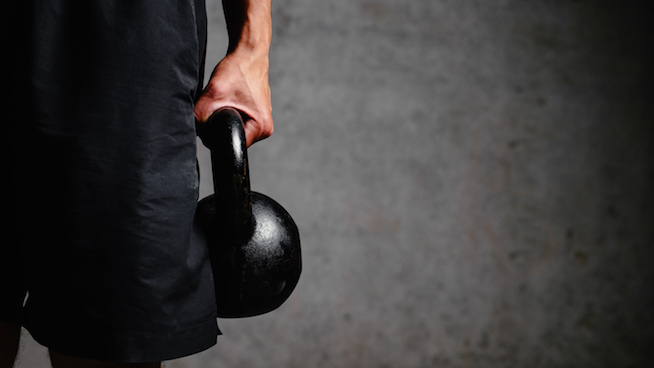
This kettlebell core exercise may seem like a walk in the park at first glance, but you’ll quickly realize the benefits once you give it a go. Kettlebell Suitcase Carries require you to hold a heavy kettlebell in one hand and simply walk for a pre-determined distance or period of time. The key is preventing your torso from leaning to the weighted side as you stroll, which requires you to active a plethora of core muscles, particularly in and around the obliques and lower back. Renowned strength and conditioning specialist Mike Boyle compares it to a moving Side Plank. Kettlebell Suitcase Carries are what’s known as an “anti-lateral flexion” core exercise, which are another great type of core exercise for athletes.
How to:
- Pick up a kettlebell in your left hand.
- Standing straight up with your core activated and shoulders rolled down and back, begin walking.
- As you walk, focus on using your core to stabilize your torso and prevent it from tilting over
Remember to breathe as you walk. - Once you’ve walked the pre-determined distance, take a short break, switch hands and walk back.
- You can go pretty heavy with these once you’ve mastered the movement, loading up to around half your own body weight.
Sets/Reps: 3×30-60 yards on each side
5. Kettlebell Swing
The Kettlebell Swing is a powerhouse of an exercise that trains and corrects many weaknesses commonly found in the modern athlete. This exercise primarily targets the glutes and lower back, two areas that are not always considered part of the core, but perhaps should be. After all, it’s difficult to say an athlete truly has a “strong core” if these two key areas are underdeveloped. Kettlebell Swings train the all-important hip hinge pattern, which is what allows athletes to utilize the full power of their glutes during explosive movements like jumping. But make no mistake—you cannot perform this exercise without a major contribution from you core. A loose core makes for a sloppy, unexplosive Kettlebell Swing and puts stress on your spine. Keep your core tight throughout the exercise as if bracing for a punch. This will help train your core to transfer energy from your lower half into your upper half.
How To:
See above video
Sets/Reps: 3×6-10
6. Quadruped Bird Dog Kettlebell Rows
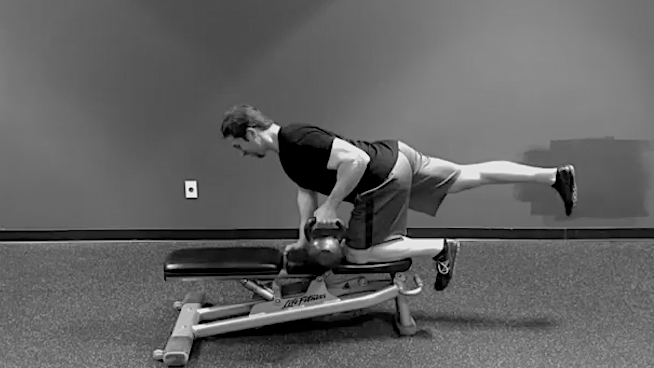
Warning—you’ll want to have mastered the standard Bird Dog before you give this challenging kettlebell core exercise a shot. But if you have, get ready for an awesome exercise that gives you a ton of bang for your buck. Dr. Joel Seedman, strength coach and owner of Advanced Human Performance, is a huge fan of this move for several reasons, one being how it aggressively activates the core. Quadruped Bird Dog Kettlebell Rows force the core to resist both extension and rotation while maintaining a neutral spine, aiding in posture problems and reducing the energy leaks that sap athletes of their explosiveness.
How to:
- While maintaining a neutral spine, kneel on a bench in a quadruped position with your knees under your hips and your hands under your shoulders.
- Pick up a kettlebell in your left hand while extending your right leg straight out, keeping your abs braced, stomach in and your whole body in one straight line from head to foot.
- Perform a slow row with the kettlebell, mimicking the tempo shown in this video. The goal is to resist rotation and extension forces that attempt to destabilize your spine.
Sets/Reps: 3×6-8 with each arm
7. Kettlebell Single-Arm Windmill
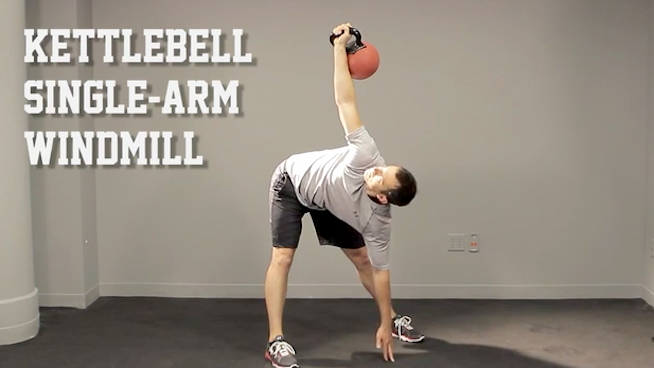
Holding this position is tough with only your body weight, let alone with a kettlebell. During this kettlebell exercise, your core has to work overtime while your shoulder stabilizers fire to balance the kettlebell with your arm in the air. Also, the twisting motion increases hip and t-spine mobility. The result is a stronger, more resilient core.
How to:
- Stand with your feet slightly wider than hip-width, and hold the kettlebell in your left hand.
- Raise your left arm straight up in the air directly over your left shoulder.
- Slowly lower your right hand toward the ground in front of you. Once you reach the ground, your arms should form a straight line from the kettlebell to the ground.
- Engage your core and reverse the move back to starting position, maintaining straight arms throughout the move.
- Start light with these, only increasing weight once you’ve mastered the movement.
Sets/Reps: 3-4×5-8 each arm
Photo Credit: BartekSzewczyk/iStock, Halfpoint/iStock
READ MORE:
RECOMMENDED FOR YOU
The 7 Most Powerful Kettlebell Core Exercises
Kettlebells are an excellent training tool.
Thanks to their versatility, kettlebells can be used to train a huge number of different muscle groups—including those in and around the core. The core is extremely important to athletic performance, as it acts to stabilize the body and transfer energy through the limbs. Think of having a weak core like putting a flimsy link in the middle of a chain. Once enough force is involved, the link won’t be up to the task of handling and transferring that energy, rendering movement inefficient and unimpressive.
With that in mind, here are seven of the most powerful kettlebell core exercises you can utilize in your routine. Feel free to superset several of these exercises for a killer kettlebell core workout.
1. Plank With Kettlebell Pull-Through

Planks have long been a staple of athletic training, but adding some dynamic movement to a static Plank can go a long way toward building functional strength through your core. By simply pulling a kettlebell from one side of your torso to the other while holding a Plank, your core must work to prevent your body from rotating. This makes the Plank with Kettlebell Pull-Through an anti-rotation core exercise. Start light with this one before progressing to heavier kettlebells. The further you place the kettlebell outside of your frame, the more difficult the exercise will become, though you should never place it so far away that it compromises the form of your Plank.
How to:
- Begin in a natural High Plank position with a kettlebell by your left side.
- While working to keep your chest parallel to the floor and resisting movement throughout the rest of your body, slide your right arm underneath yourself to grab the kettlebell handle.
- Remaining in a good Plank position with your butt down and core engaged, pull the kettlebell underneath yourself to the other side.
- Continue to pull the kettlebell to alternating sides until the set is complete.
Sets/Reps: 3×10-12 total reps
2. Resurrected Dead Bug

The Dead Bug has long been one of our favorite core exercises, as it trains the core to resist extension and protect your lower back. Anti-rotation and anti-extension exercises are excellent choices for your core training, as they train the musculature in a functional, natural manner.
This variation, from renowned strength expert Dan John, looks different from a standard Dead Bug, but the pattern is the same. As you hold a kettlebell over your chest, do a leg raise and drive your legs into the air. This works the frontside of your core and opens up your lower back. The key with this kettlebell core exercise is to prevent your lower back from raising off the floor as you lower your legs. While your lower back will naturally come off the mat as you pulse your feet in the air, you should work to keep your lower back in contact with the floor for the rest of the movement.
How to:
- Hold a kettlebell or med ball with your arms extended in front of your chest.
- Keeping your lower back flat on the ground and legs straight, slowly lower your legs until your feet are a few inches above the ground.
- Raise your legs up until they are perpendicular to the ground and then drive your hips into the air to pulse your feet.
- Control the descent by activating your core and repeat.
Sets/Reps: 3×8-10 reps
3. Kettlebell Turkish Get-Up
[youtube video=”KglXLn1LjGw”]Kettlebell Turkish Get-Ups are a monster of a movement. Some experts have even proposed they may deserve the title of “world’s greatest exercise,” and it’s hard to fault them. The beauty of the Kettlebell Turkish Get-Up is that it’s really four or five exercises in one. Transitioning between each of those exercise positions requires excellent functional core strength. If you’ve never performed Turkish Get-Ups before, you may want to first start without any weight to see if you have the mobility and full-body strength required to execute the move appropriately.
How to:
See above video
Sets/Reps: 3×3-5 reps on each side
4. Kettlebell Suitcase Carry

This kettlebell core exercise may seem like a walk in the park at first glance, but you’ll quickly realize the benefits once you give it a go. Kettlebell Suitcase Carries require you to hold a heavy kettlebell in one hand and simply walk for a pre-determined distance or period of time. The key is preventing your torso from leaning to the weighted side as you stroll, which requires you to active a plethora of core muscles, particularly in and around the obliques and lower back. Renowned strength and conditioning specialist Mike Boyle compares it to a moving Side Plank. Kettlebell Suitcase Carries are what’s known as an “anti-lateral flexion” core exercise, which are another great type of core exercise for athletes.
How to:
- Pick up a kettlebell in your left hand.
- Standing straight up with your core activated and shoulders rolled down and back, begin walking.
- As you walk, focus on using your core to stabilize your torso and prevent it from tilting over
Remember to breathe as you walk. - Once you’ve walked the pre-determined distance, take a short break, switch hands and walk back.
- You can go pretty heavy with these once you’ve mastered the movement, loading up to around half your own body weight.
Sets/Reps: 3×30-60 yards on each side
5. Kettlebell Swing
The Kettlebell Swing is a powerhouse of an exercise that trains and corrects many weaknesses commonly found in the modern athlete. This exercise primarily targets the glutes and lower back, two areas that are not always considered part of the core, but perhaps should be. After all, it’s difficult to say an athlete truly has a “strong core” if these two key areas are underdeveloped. Kettlebell Swings train the all-important hip hinge pattern, which is what allows athletes to utilize the full power of their glutes during explosive movements like jumping. But make no mistake—you cannot perform this exercise without a major contribution from you core. A loose core makes for a sloppy, unexplosive Kettlebell Swing and puts stress on your spine. Keep your core tight throughout the exercise as if bracing for a punch. This will help train your core to transfer energy from your lower half into your upper half.
How To:
See above video
Sets/Reps: 3×6-10
6. Quadruped Bird Dog Kettlebell Rows

Warning—you’ll want to have mastered the standard Bird Dog before you give this challenging kettlebell core exercise a shot. But if you have, get ready for an awesome exercise that gives you a ton of bang for your buck. Dr. Joel Seedman, strength coach and owner of Advanced Human Performance, is a huge fan of this move for several reasons, one being how it aggressively activates the core. Quadruped Bird Dog Kettlebell Rows force the core to resist both extension and rotation while maintaining a neutral spine, aiding in posture problems and reducing the energy leaks that sap athletes of their explosiveness.
How to:
- While maintaining a neutral spine, kneel on a bench in a quadruped position with your knees under your hips and your hands under your shoulders.
- Pick up a kettlebell in your left hand while extending your right leg straight out, keeping your abs braced, stomach in and your whole body in one straight line from head to foot.
- Perform a slow row with the kettlebell, mimicking the tempo shown in this video. The goal is to resist rotation and extension forces that attempt to destabilize your spine.
Sets/Reps: 3×6-8 with each arm
7. Kettlebell Single-Arm Windmill

Holding this position is tough with only your body weight, let alone with a kettlebell. During this kettlebell exercise, your core has to work overtime while your shoulder stabilizers fire to balance the kettlebell with your arm in the air. Also, the twisting motion increases hip and t-spine mobility. The result is a stronger, more resilient core.
How to:
- Stand with your feet slightly wider than hip-width, and hold the kettlebell in your left hand.
- Raise your left arm straight up in the air directly over your left shoulder.
- Slowly lower your right hand toward the ground in front of you. Once you reach the ground, your arms should form a straight line from the kettlebell to the ground.
- Engage your core and reverse the move back to starting position, maintaining straight arms throughout the move.
- Start light with these, only increasing weight once you’ve mastered the movement.
Sets/Reps: 3-4×5-8 each arm
Photo Credit: BartekSzewczyk/iStock, Halfpoint/iStock
READ MORE:




